Key takeaways:
- Understanding composition is essential for storytelling in photography, enhancing emotional connections with viewers.
- Techniques like the rule of thirds, leading lines, and framing can significantly improve the visual impact of photographs.
- Engaging with fellow photographers for feedback can provide valuable insights and foster personal growth in composition skills.
- Practical exercises, such as focusing on a single subject, help deepen understanding and mastery of composition techniques.
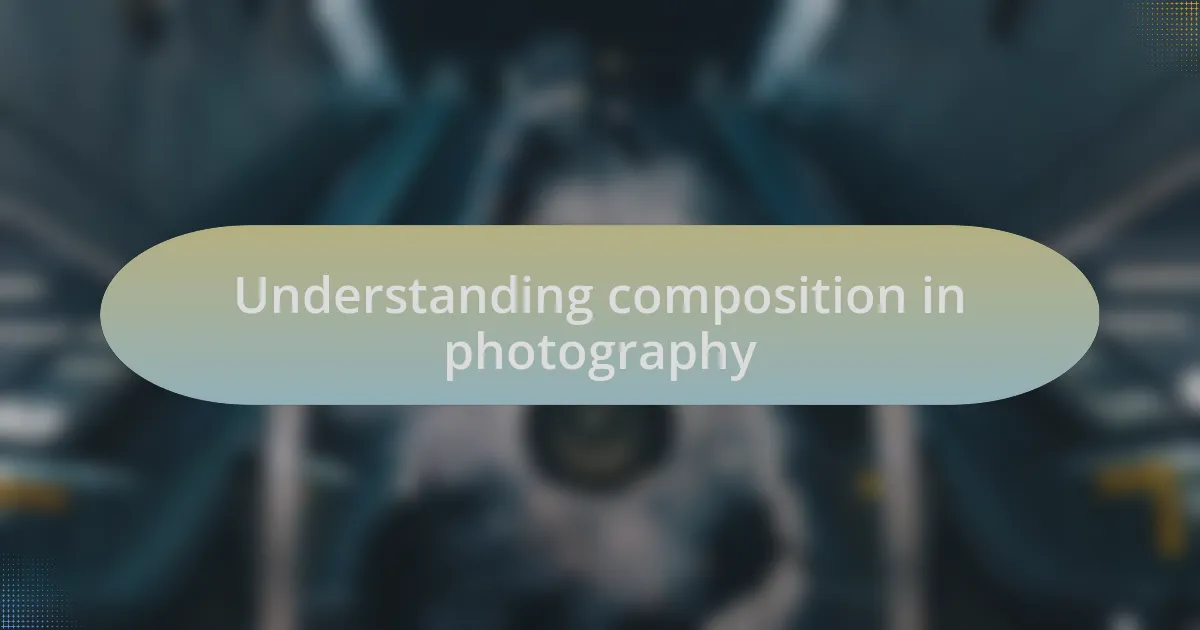
Understanding composition in photography
When I first began exploring composition in photography, I realized it wasn’t just about placing the subject in the frame; it was about telling a story. I remember standing in a park, capturing a moment of a child playing, and quickly learned that the angle and background could transform an ordinary shot into something magical. Have you ever taken a photo and felt it just didn’t capture the feeling of that moment? I often found myself in that position until I started to truly understand how elements like leading lines and the rule of thirds could enhance my storytelling.
As I delved deeper, I discovered the concept of balance and symmetry. In one of my early outings, I shot a landscape where the sky seemed overpowering, throwing everything else off-kilter. It was a learning moment, prompting me to consciously think about how different components of the frame interact. I began asking myself, “Am I giving equal attention to foreground and background?” This shift in mindset significantly improved my ability to create more visually engaging photos.
Another aspect I found fascinating was the emotional power of composition. A powerful image often evokes a feeling—a sense of peace, excitement, or nostalgia. On a trip to the coast, I snapped a photo of crashing waves with a dramatic sunset. It wasn’t just about the colors; it was about positioning the waves to lead the viewer’s gaze toward the horizon. That experience taught me how intentional composition could evoke emotion and create a stronger bond between the viewer and the photograph. What emotions do you want to evoke in your images?
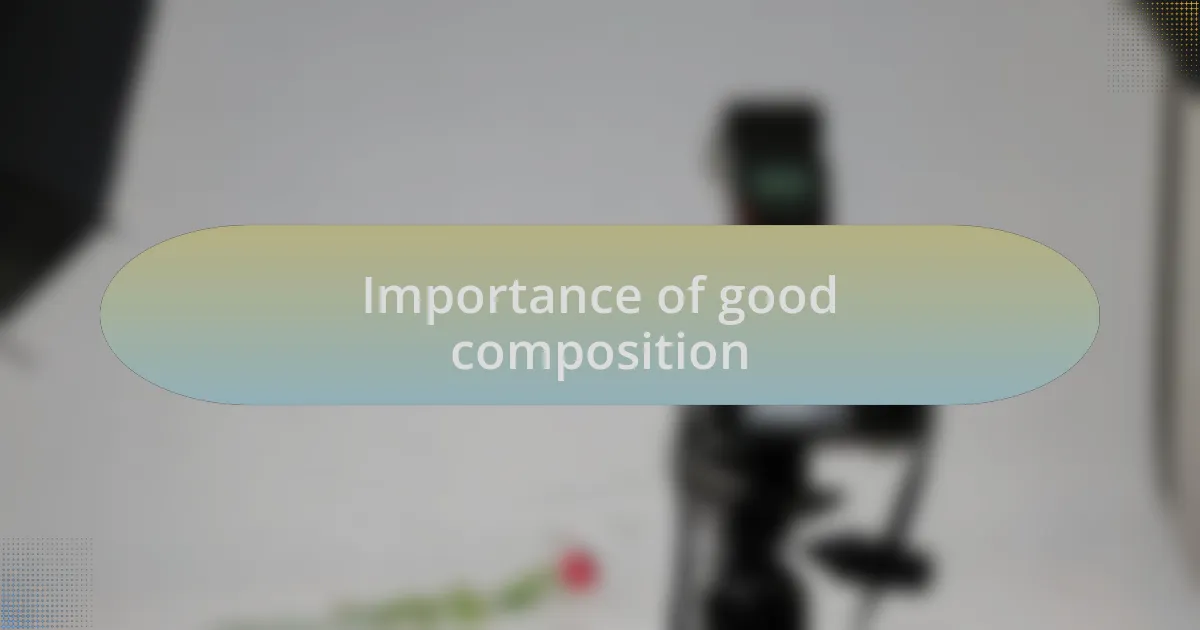
Importance of good composition
Good composition is the backbone of impactful photography. Early on, while photographing a bustling city market, I learned that where you place your subject—a vendor or a colorful display—can either engage or overwhelm the viewer. An image that draws the eye offers a much deeper connection, prompting the viewer to explore every corner of the frame. Have you ever noticed how a well-composed shot makes you pause and reflect?
In my journey, I found that good composition also serves to guide the viewer’s journey through the image. For instance, I shot a portrait where the subject’s gaze led the viewer’s eyes through the background elements, creating a narrative. I felt thrilled seeing how small adjustments—like changing the depth of field—could make the difference between a lifeless image and one that sparked curiosity. It made me wonder: how much can a simple tweak in composition change the entire story you’re trying to tell?
Moreover, I believe composition has an uncanny ability to evoke emotions. I recall capturing a quiet moment of an elderly couple holding hands in a park, framed by blooming flowers. The way I arranged the elements conveyed warmth and intimacy, bringing a sense of nostalgia to the image. It’s moments like these that highlight how a keen understanding of composition can not only enhance visual appeal but also resonate emotionally with viewers. What stories do your images tell?
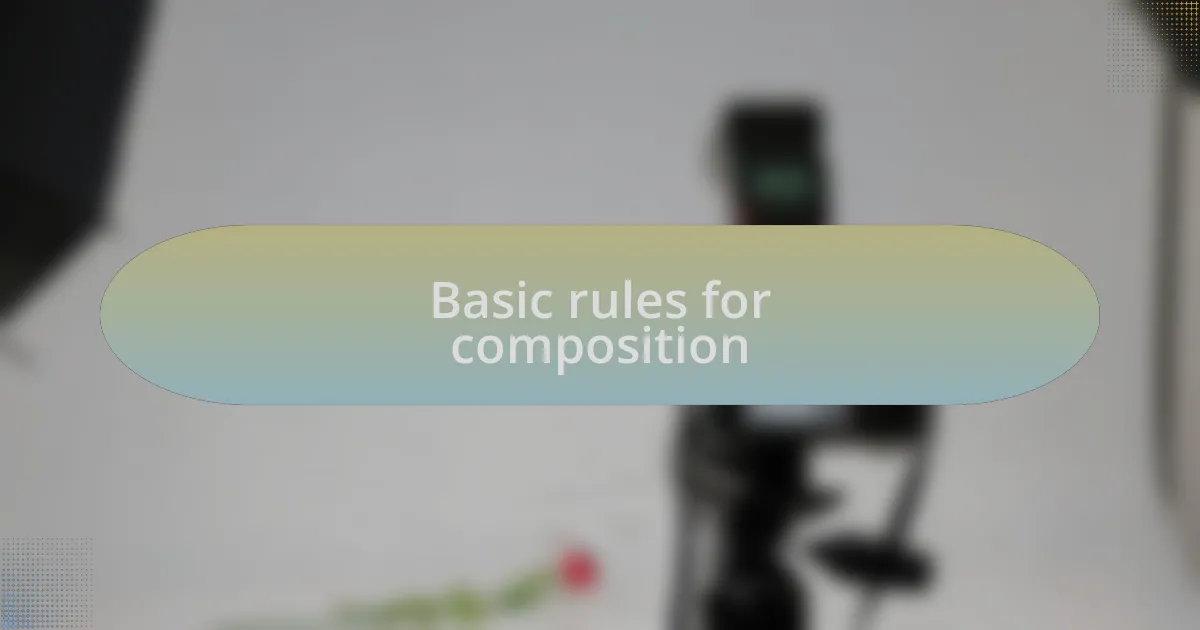
Basic rules for composition
Good composition starts with understanding the rule of thirds. While photographing a sunset, I positioned the horizon line along the lower third, allowing the vibrant sky to dominate the frame. This simple choice transformed a typical snapshot into a striking visual that drew me in, making me think: what other scenes could benefit from this classic technique?
I have also come to appreciate the importance of leading lines. In one of my urban shots, I found an intricate path winding through a park, naturally guiding the viewer’s gaze toward a distant sculpture. It was exhilarating to see how that simple line not only created depth but also invited observers to ‘walk’ through the image. Have you ever used a line effectively in your own photography?
Lastly, effective composition often hinges on framing your subject. I once encountered a scene where an archway created a perfect frame for a musician playing in the street. This not only added visual interest but also focused attention on the performer’s emotion. It made me realize that framing can turn a good photograph into a captivating story. What elements do you think might work as frames in your shots?
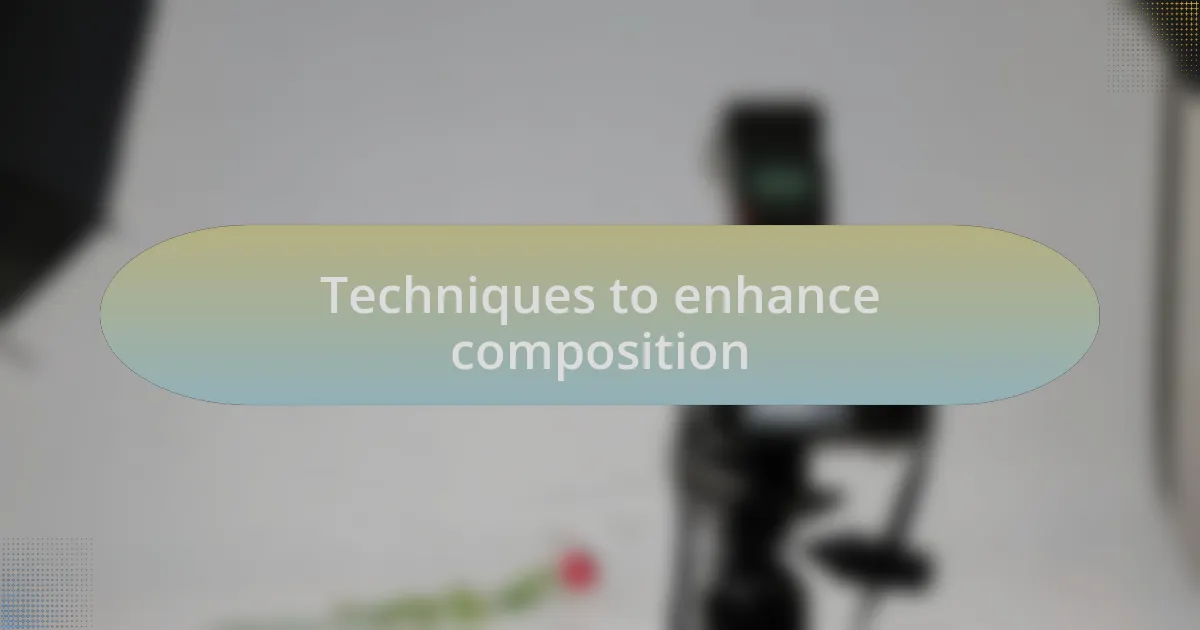
Techniques to enhance composition
One technique I find incredibly effective is using negative space to enhance the main subject. I remember a day at the beach where I isolated a lone surfer against a vast expanse of ocean and sky. By keeping the background minimal, the focus shifted entirely to the surfer’s determination, transforming an ordinary scene into a powerful narrative. Have you ever tried using emptiness to create emphasis in your images?
Balancing elements within the frame is another technique that I’ve experimented with. I once shot a landscape where the mountains on one side were beautifully complemented by a field of flowers on the other. This visual balance not only held the viewer’s attention but also created a sense of harmony. Isn’t it fascinating how a simple adjustment can shift the entire feel of a composition?
Exploring different perspectives has also opened up exciting possibilities for my photography. While visiting a local market, I crouched down to capture vendors from beneath their tables, revealing an entirely new world that’s often missed. This fresh viewpoint not only sparked curiosity but also told a story that was completely authentic. Have you considered changing your angle to unveil hidden layers in your scenes?
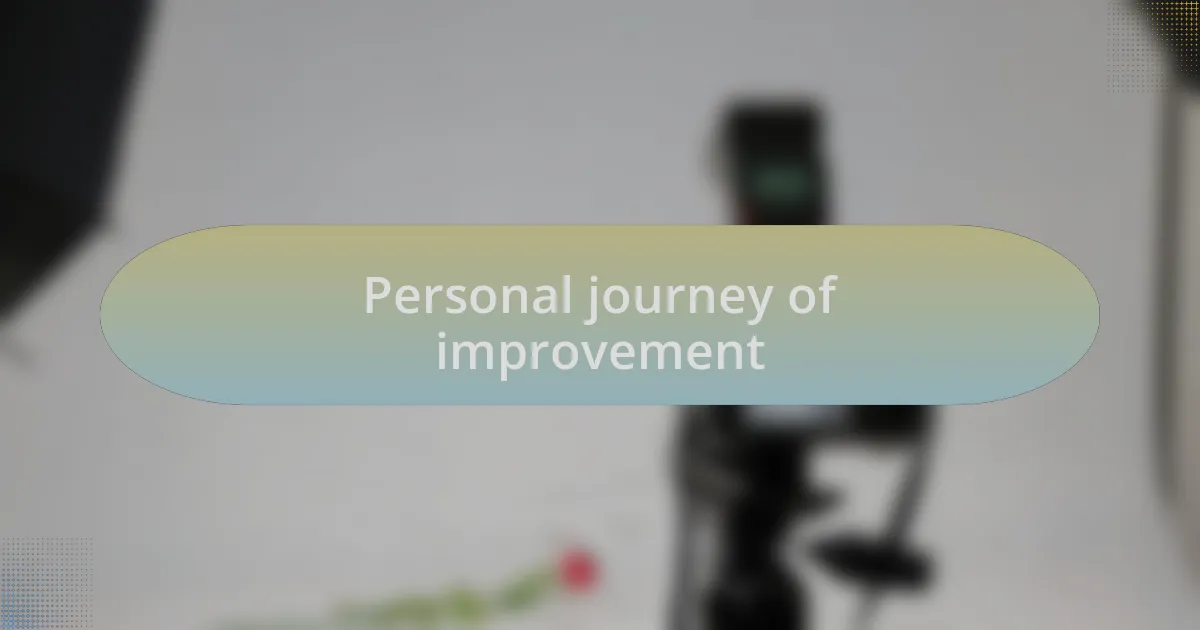
Personal journey of improvement
As I reflect on my journey to improve my composition skills, I can’t help but think of the moments that truly shaped my perspective. There was a rainy afternoon when I decided to capture the essence of solitude. I positioned myself by a window, letting the raindrops blur the outside world. This simple act of embracing the weather opened my eyes to how mood can influence composition. Have you ever noticed how different lighting can evoke distinct feelings in your images?
Another memorable milestone was when I joined a local photography club. I found myself surrounded by enthusiastic photographers who offered constructive critiques of my work. One member suggested I focus more on leading lines, and that advice changed everything for me. I experimented with roads and paths in my images, discovering how they could guide viewers’ eyes through the frame. Have you sought feedback from fellow photographers? It can be incredibly insightful.
Then, there was that unforgettable trip to the mountains. Climbing to a high vantage point, I was struck by the vastness of the landscape before me. I felt a mix of awe and humility as I realized the importance of scale in composition. Whether capturing the grandeur of nature or intimate details of daily life, I learned to appreciate the stories that spaces hold. Have you ventured into the world around you with fresh eyes? Often, it’s the change in perspective that catalyzes growth.
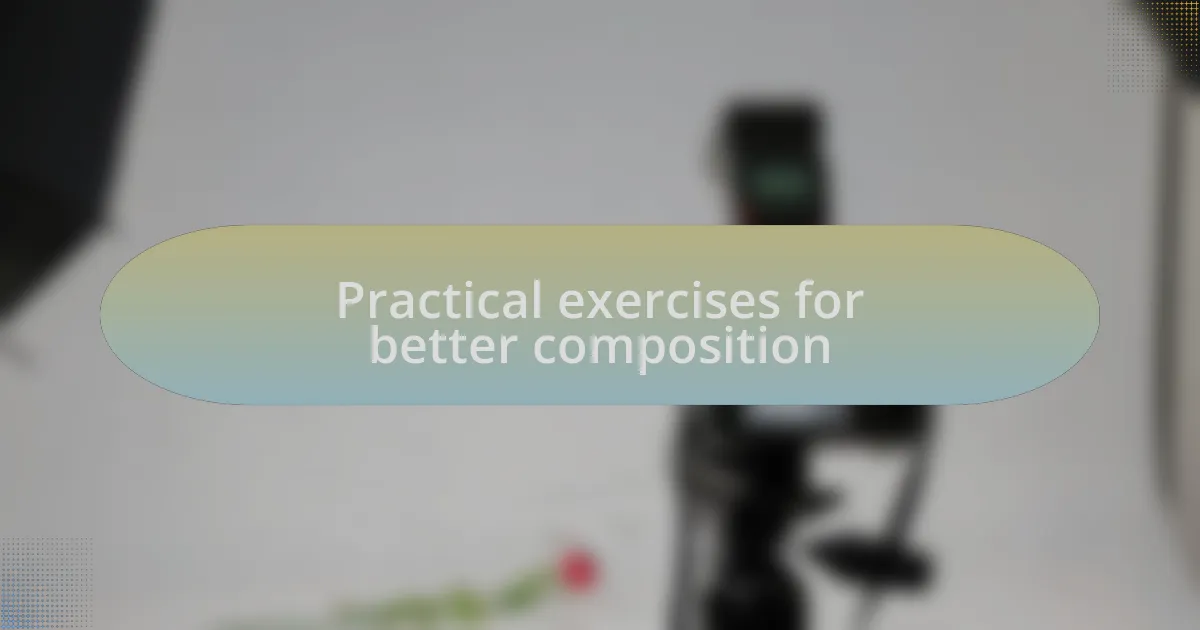
Practical exercises for better composition
When it comes to practical exercises for enhancing composition, one of my favorites is the “Frame Within a Frame” technique. I found myself at a bustling café one afternoon, using doorways and window frames to direct attention toward my subjects. It was fascinating to see how this simple adjustment added layers to my images. Have you tried finding natural frames in your environment? It can totally transform the narrative of a photograph.
Another exercise I often recommend is the “One Subject Challenge.” I set a timer for an hour and focused on a single object, like a flower in my garden. I experimented with different angles and backgrounds, and each shot revealed new facets of that subject I hadn’t initially considered. It made me realize how much I often overlook when I’m in a rush. Have you ever concentrated on just one subject for an extended period? It’s a powerful way to deepen your skills.
Lastly, I can’t stress the importance of the rule of thirds enough. I still remember the day I consciously applied it at a local park, dividing my frame into thirds mentally. When I composed an image of a tree off to one side, it suddenly became more balanced and engaging. Have you tried visualizing your shots this way? The impact can be genuinely transformative, letting your audience connect more deeply with your work.
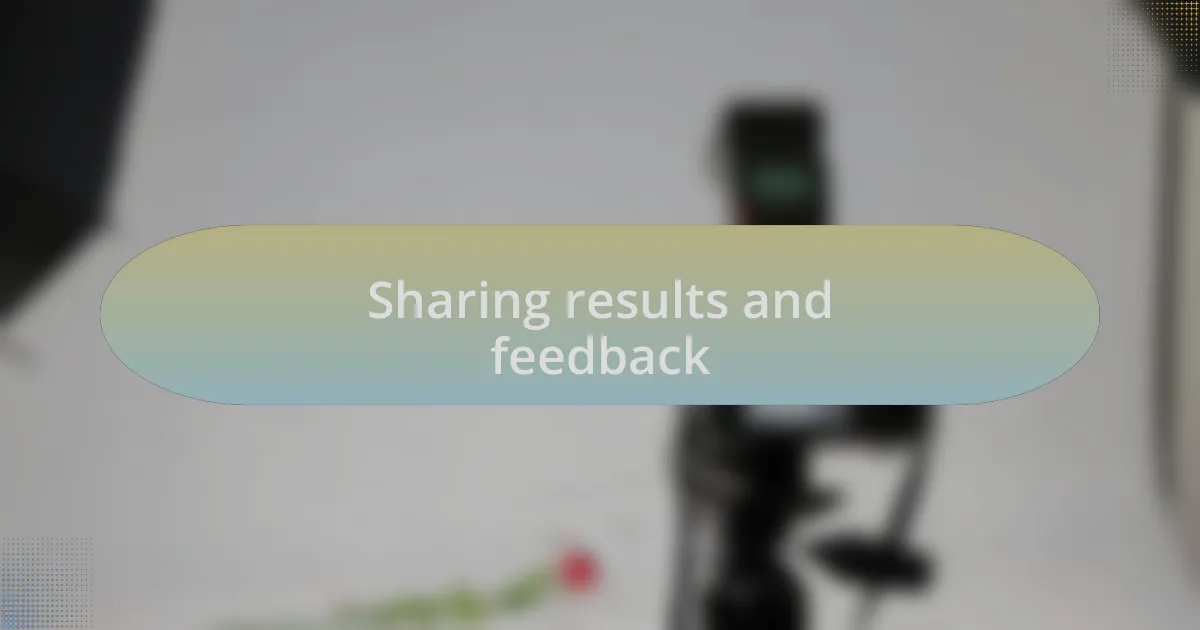
Sharing results and feedback
Sharing your results and seeking feedback can be incredibly enlightening. I recall the first time I posted my photographs in an online forum. The constructive criticisms and praises I received opened my eyes to perspectives I hadn’t even considered. Have you ever felt that rush of excitement when someone appreciates your work? It’s both validating and motivating.
Feedback can sometimes sting, but it’s crucial for growth. I remember sharing a landscape shot that I was particularly proud of, only to receive comments about its overexposure. Initially, I felt defensive; however, reflecting on the feedback led me to revise my editing process. Can you think of a time when feedback helped you improve? Embracing constructive criticism can lead to significant breakthroughs in your skills.
I also love sharing my progress with fellow photographers. I’ve created a small group where we share our latest compositions and provide honest feedback. It’s refreshing to see how different viewpoints can reveal aspects of my work that I might overlook. Isn’t it fascinating how collaboration can spark creativity? Engaging with others not only improves my composition skills but also fosters a sense of community among us.